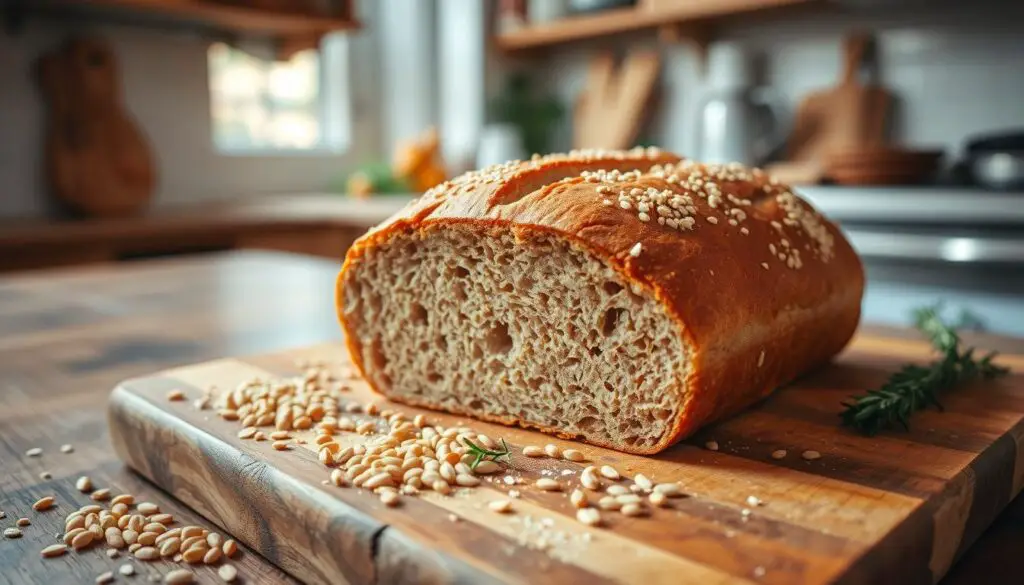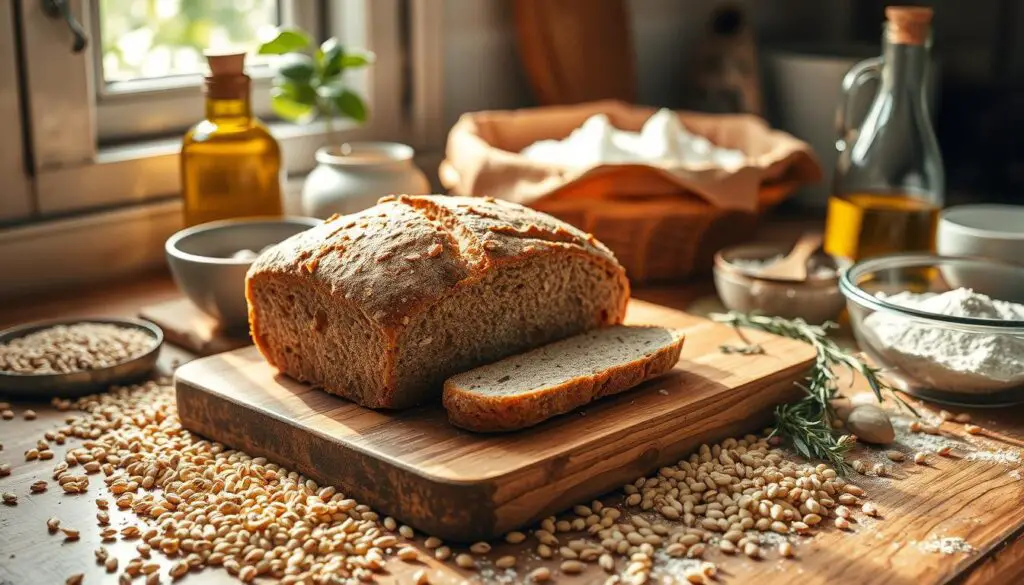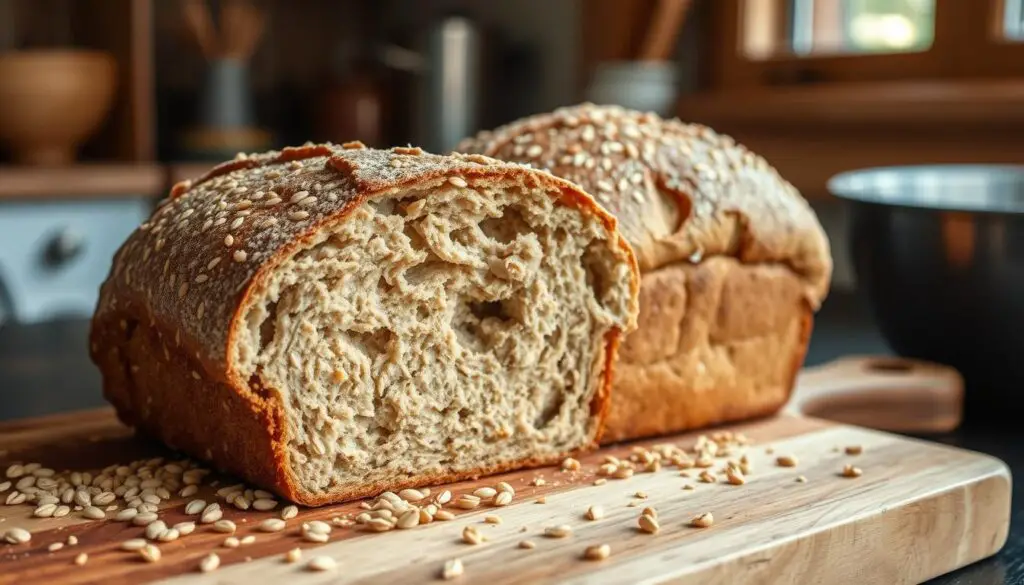- Looking for a gluten-free hero loaf that’s healthy and delicious? This buckwheat bread recipe is here to make your taste buds dance and your baking feel effortless. Bonus: it doubles as a great excuse for butter!
Being a busy parent can make baking bread seem hard. But, making a tasty, healthy loaf is simpler than you think. Buckwheat bread is a great choice. It’s gluten-free and packed with vitamins and minerals.
Table of Contents

I’ll show you how to make buckwheat bread at home. It’s perfect for a healthier option or to try gluten-free baking. You’ll love the nutty taste and soft texture of this bread.
Key Takeaways
- Buckwheat bread is a gluten-free, nutrient-dense alternative to traditional wheat bread.
- Baking homemade buckwheat bread is easier than you might think, with simple ingredients and a straightforward process.
- Discover the unique flavor and health benefits of incorporating buckwheat into your baking routine.
- Enjoy the versatility of buckwheat bread, which can be used for a variety of meals and snacks.
- Learn tips and tricks for successful buckwheat bread baking, from proper storage to mixing techniques.
Understanding Buckwheat Bread: A Nutritious Ancient Grain Alternative
Buckwheat is not a grain but a seed packed with nutrients. It has been a key ingredient in baking for centuries. Coming from Asia, it’s loved worldwide for its taste and health perks.
The History of Buckwheat in Traditional Baking
In Eastern Europe and Asia, buckwheat has been a mainstay for thousands of years. In Russia and Japan, it’s used in dishes like blini and soba noodles. Its nutritious flour makes it perfect for breads, pancakes, and more.
Health Benefits of Choosing Buckwheat
- It’s full of dietary fiber, which is good for your digestion and keeps you full
- It’s rich in vitamins and minerals like magnesium, copper, and manganese
- It has plant compounds like rutin, which are antioxidants
- It’s gluten-free, great for those with gluten issues or celiac disease
Why Buckwheat Isn’t Actually Wheat
Buckwheat isn’t related to wheat. It’s a seed, often called a “pseudocereal.” This means it’s used like a grain but isn’t a grass family member. This is key for those on gluten-free diets or looking for grain alternatives.
“Buckwheat is a highly nutritious and versatile ingredient that has been used in traditional baking for centuries. Its unique properties make it a great alternative to wheat-based flours.”
Essential Ingredients for Perfect Buckwheat Bread
Making delicious buckwheat bread starts with the right ingredients. Buckwheat flour is key, offering a nutty taste and soft texture. Adding the right leavening agents and optional extras makes the loaf truly special.
Here are the must-have ingredients for perfect buckwheat bread:
- Buckwheat Flour – This gluten-free flour is the main ingredient. Choose high-quality, whole food ingredients and sprouted buckwheat for the best taste and nutrition.
- Leavening Agents – Baking soda and baking powder help the bread rise, making it light and airy.
- Salt – A little salt enhances the flavor and balances the sweetness.
- Liquids – Use milk, yogurt, or water to add moisture to the dough.
- Sweeteners (Optional) – Honey, maple syrup, or brown sugar can add a hint of sweetness.
- Fats (Optional) – Butter, coconut oil, or olive oil make the bread richer and softer.
- Mix-Ins (Optional) – Adding nuts, seeds, dried fruits, or herbs can create unique flavors.
Choosing and measuring these ingredients carefully will help you bake a tasty and healthy buckwheat bread. It will please your taste buds and nourish your body.
| Ingredient | Purpose |
|---|---|
| Buckwheat Flour | Provides the base for the bread, contributing to its unique flavor and texture. |
| Leavening Agents (Baking Soda and Baking Powder) | Help the bread rise, creating a light and airy crumb. |
| Salt | Enhances the overall flavor and balances the sweetness. |
| Liquids (Milk, Yogurt, or Water) | Add moisture to the dough, allowing it to come together and bake properly. |
| Sweeteners (Optional) | Provide a subtle sweetness to the bread, complementing the nutty buckwheat flavor. |
| Fats (Optional) | Contribute to a richer, more tender texture in the finished loaf. |
| Mix-Ins (Optional) | Add unique flavors and textures to the bread, such as nuts, seeds, dried fruits, or herbs. |
Required Kitchen Tools and Equipment
To bake the perfect loaf of artisanal buckwheat bread, you need some key tools and equipment. From basic baking tools to advanced options, the right gear makes a big difference. It helps you on your bread-making journey.
Basic Baking Tools You’ll Need
- Mixing bowls in various sizes
- Wooden or silicone spatulas for stirring and folding
- A sturdy bread loaf pan or baking sheet
- A sharp bread knife for slicing
- Measuring cups and spoons for accurate ingredient portioning
Optional Equipment for Advanced Baking
If you want to improve your artisanal baking, consider these tools:
- A stand mixer with a dough hook attachment for effortless kneading
- A bread proofing basket (also known as a banneton) for shaping the dough
- A Dutch oven or baking stone for creating a professional-grade crust
- A digital kitchen scale for precise ingredient weighing
Measuring and Temperature Tools
When baking with artisanal buckwheat flour, precise measurements and temperature control are key. Make sure you have these tools:
- A digital kitchen thermometer to monitor yeast activation and dough temperature
- A meat or oven thermometer to ensure the bread is baked to perfection
- Measuring cups and spoons for accurate dry and wet ingredient portioning
With the right tools and equipment, you’ll be well on your way to baking delicious, artisanal buckwheat bread right at home.
Step-by-Step Guide to Making Buckwheat Bread
Making your own vegan bread recipe or gluten-free baking is rewarding. To make delicious buckwheat bread, follow a clear process. This ensures the right texture and flavor.
- Gather all the necessary ingredients, including buckwheat flour, yeast, water, salt, and any additional mix-ins you desire.
- In a large mixing bowl, combine the buckwheat flour, yeast, and salt. Stir to blend the dry ingredients together.
- Slowly add the warm water to the dry mixture, and use a wooden spoon or your hands to knead the dough until it forms a cohesive ball. The dough should be slightly sticky but not overly wet.
- Transfer the dough to a lightly floured surface and knead it for 5-10 minutes, until it becomes smooth and elastic.
- Place the dough in a greased loaf pan or on a parchment-lined baking sheet, cover it with a damp towel, and let it rise for about an hour, or until it has doubled in size.
- Preheat your oven to 375°F (190°C).
- Once the dough has risen, gently score the top with a sharp knife or lame, and bake for 30-40 minutes, or until the crust is golden brown and the internal temperature reaches 205-210°F (96-99°C).
- Remove the bread from the oven and let it cool on a wire rack for at least 30 minutes before slicing and serving.
Keep an eye on the bread while it bakes. Oven temperatures and times can differ. With practice, you’ll make a gluten-free baking or vegan bread recipe that will impress everyone!

Tips for Working with Buckwheat Flour
Exploring gluten-free baking with nutritious flour like buckwheat opens new culinary doors. Whether you’re an experienced baker or new to it, knowing how to handle buckwheat flour is crucial. It ensures your baked goods always taste great.
Proper Storage Methods
Buckwheat flour spoils quickly, so it’s vital to store it right. Place it in an airtight container in a cool, dry spot, out of sunlight. This keeps its taste and texture fresh. For longer storage, put it in the fridge or freezer.
Mixing and Kneading Techniques
Buckwheat flour is softer than regular flour, so be gentle when mixing and kneading. Don’t overwork the dough, as it can become dense. Just mix the ingredients softly and knead until the dough forms.
Temperature Considerations
- Proofing: Buckwheat dough needs a warmer spot, about 80-85°F (26-29°C), for the best rise.
- Baking: Lower your oven temperature to 375-400°F (190-205°C). This stops the outside from burning before the inside is done.
Learning these tips for gluten-free baking and nutritious flour will help you make tasty homemade buckwheat bread. It’s both delicious and healthy.
Common Mistakes to Avoid When Baking With Buckwheat
Baking with buckwheat flour is a fun and healthy adventure. But, it has its own challenges. Knowing common mistakes helps make your buckwheat bread perfect every time.
One big mistake is not realizing how much liquid buckwheat flour absorbs. It soaks up more than regular wheat flour. So, adjust your recipe to get the right mix of flour and liquid.
- Overproofing the dough: Buckwheat bread is sensitive to overproofing. This makes it dense and heavy. Watch the rising time closely.
- Inadequate kneading: Kneading is key for buckwheat bread. It helps create a good texture. Knead well to get a nice crumb.
- Baking at the wrong temperature: Buckwheat flour burns easily. So, check your oven temperature and adjust it to avoid a burnt crust.
- Neglecting to grease the pan: Buckwheat bread sticks to pans. Grease the pan well to make it easy to remove and clean.
By avoiding these mistakes and adjusting your baking, you can become a pro at gluten-free baking with buckwheat. Enjoy making tasty, healthy bread alternatives in your kitchen.

“Baking with buckwheat flour is a unique and rewarding experience. With a little knowledge and some practice, you can create beautifully textured, nutrient-rich loaves that will delight your taste buds.”
Variations and Flavor Additions to Try
Baking with buckwheat flour lets you explore many tasty options. You can make your bread sweet or savory by adding different ingredients. This way, you can make your buckwheat bread truly special.
Sweet and Savory Options
For a sweet twist, add dried fruit like raisins or cranberries. A drizzle of honey or cinnamon sugar can also enhance the flavor. For a savory taste, mix in herbs like rosemary or thyme. Grated cheese like Parmesan can also add a nice touch.
Seed and Nut Combinations
Buckwheat bread is great with seeds and nuts. Try adding sunflower seeds or pumpkin seeds for crunch. Chopped walnuts or almonds can also add a nice texture and flavor.
| Sweet Additions | Savory Additions | Seed and Nut Combinations |
|---|---|---|
| Dried fruit (raisins, cranberries, apricots) Honey Cinnamon sugar | Herbs (rosemary, thyme, oregano) Grated cheese (Parmesan, cheddar) | Sunflower seeds Pumpkin seeds Chopped walnuts or almonds |
Baking with buckwheat flour is all about creativity. It offers a nutty base that you can customize. Feel free to try different ingredients to make your buckwheat bread your own.
Storage Tips and Shelf Life
Keeping your homemade buckwheat bread fresh is key to enjoying it fully. Whether you plan to eat it soon or later, the right storage can make a big difference. Here are some tips to keep your healthy bread alternatives tasting great.
Countertop Storage
For a short time, you can store your buckwheat bread on the counter, uncovered, for 2-3 days. This keeps the crust crisp. Store it in a cool, dry spot, away from sunlight or heat to prevent drying out.
Refrigeration
To keep your bread longer, the fridge is a good choice. Wrap it tightly in plastic wrap or a bag for up to 1 week. The crust might get softer, but it will still be tasty.
Freezing
- Freezing is great for longer storage. Wrap the loaf or slices in plastic or foil, then in a bag or container.
- Buckwheat bread stays good for up to 3 months in the freezer.
- To thaw, let it sit at room temperature or in the fridge before eating.
Always check your buckwheat bread for mold or bad smells. Use your senses to decide if it’s still good.
With these storage tips, you can enjoy your homemade buckwheat bread for a long time. It’s convenient and keeps your bread fresh for weeks.
Serving Suggestions and Pairing Ideas
Now that you’ve learned to bake delicious nutritious flour buckwheat bread, it’s time to explore serving and pairing ideas. Buckwheat bread is perfect for a healthy breakfast, lunch, or dinner. It’s a great companion for any meal.
Breakfast Combinations
Buckwheat bread is great for a nutritious breakfast. Try it with creamy avocado, rich nut butter, or tangy Greek yogurt. For something sweet, add honey or maple syrup and top with fresh berries or sliced bananas.
- Avocado toast with a sprinkle of sea salt and fresh cracked pepper
- Peanut butter and sliced banana
- Cottage cheese and a handful of blueberries
Lunch and Dinner Pairings
Buckwheat bread’s strong flavor and dense texture make it perfect for lunch or dinner. Pair it with grilled chicken, roasted veggies, or deli meats and cheeses.
- Turkey, Swiss cheese, and a tangy Dijon mustard
- Roasted beet, goat cheese, and a drizzle of balsamic glaze
- Grilled portobello mushroom, roasted red pepper, and a sprinkle of fresh basil
Buckwheat bread goes well with many cuisines, from Mediterranean to hearty comfort foods. Try different flavors and find your favorite pairings.
Troubleshooting Your Buckwheat Bread Recipe
Baking with gluten-free buckwheat flour can be rewarding but tricky for artisanal home bakers. If you’ve faced issues like a dense or crumbly bread, don’t worry. We have expert tips to help you make the perfect buckwheat bread every time.
A common problem is a dense, heavy crumb. This might happen if you over-knead the dough or don’t let it proof long enough. To fix this, mix and knead gently. Make sure your dough has enough time to rise before baking. Adding an extra 30 minutes to an hour of rest can greatly improve the texture.
Another issue is a crumbly or falling-apart loaf. This could be because of not enough binding agents or the dough being too dry. To avoid this, try adding a bit of xanthan gum or psyllium husk to your recipe. Also, watch the dough’s hydration level. Slowly add water or milk until the dough is smooth and pliable before baking.
FAQ
What makes buckwheat bread a healthy choice?
Buckwheat bread is a healthier option than regular wheat bread. It’s made from buckwheat, a gluten-free seed. This seed is full of fiber, protein, and important vitamins and minerals.
It’s also an ancient grain that people have baked with for centuries.
Is buckwheat the same as regular wheat?
No, buckwheat is not the same as regular wheat. It’s actually a seed that’s not related to wheat, rye, or barley. This makes buckwheat bread a good choice for those who can’t eat gluten.
What are the key ingredients needed to bake buckwheat bread?
To make buckwheat bread, you need buckwheat flour, yeast or baking powder, and water or plant-based milk. You can also add seeds, nuts, or dried fruit for extra texture and taste.
What kind of equipment do I need to bake buckwheat bread?
You’ll need basic kitchen tools like a mixing bowl, bread pan, and oven to bake buckwheat bread. If you’re more advanced, you might want a stand mixer or bread maker to make things easier.
How do I store leftover buckwheat bread?
Store leftover buckwheat bread in an airtight container at room temperature for up to 3 days. You can refrigerate it for up to 1 week or freeze it for months.
What are some common mistakes to avoid when baking with buckwheat flour?
Avoid over-mixing the dough to prevent a dense bread. Also, make sure to measure your ingredients correctly and consider the temperature and humidity when baking.
How can I add more flavor to my homemade buckwheat bread?
Try adding dried fruit, nuts, seeds, herbs, or spices to your bread. You can also mix buckwheat with other ancient grains like quinoa or millet for different flavors.
What are some good ways to serve buckwheat bread?
Buckwheat bread is great for breakfast toast, sandwiches, or as a side to soups and stews. Its earthy taste goes well with many toppings and fillings.

1 Comment